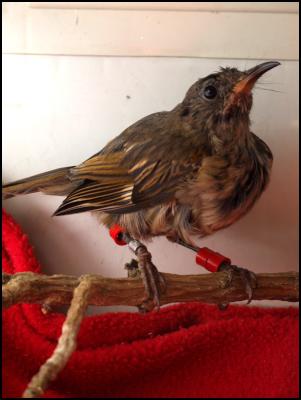Rare bird makes full recovery
Media Release
16 April 2012
Rare bird makes
full recovery

One of New Zealand's rarest birds, the Hihi, was brought to The Nest Te Kohanga at Wellington Zoo for care, after being found at Zealandia with an irregular head tilt.
Dr Lisa Argilla said that the head tilt could have been a result of either flying into something, an infection in the brain, or having consumed something poisonous.
"With such a small bird, it is hard to run the usual diagnostics to assess its condition, but we were able to x-ray the bird to ensure there were no fractures," explained Dr Argilla. "We also gave it medication to deal to any toxins that it may have ingested, as well as treating it for possible infections."
Hihi usually become stressed in a hospital environment, but this was one determined little bird. "Once it started perking up, it was very ready to get on its way! We ended up treating it in a smaller room without glass so that it wouldn't try to fly through windows."
Zealandia collected the Hihi on Wednesday afternoon to introduce it back in the sanctuary, as it had made a full recovery.
"We're really lucky to have The Nest Te Kohanga as a teaching hospital," said Dr Argilla. "Treating the more common native birds such as Kereru and Tui on a regular basis means that we are well prepared to deal with the rarer native birds when they come our way."
The Nest Te Kohanga helps to train wildlife vets around the country, which helps to ensure that native animals can receive expert hospital care.
A Hihi can be recognised by their strident call, which 19th century ornithologist Sir Walter Buller described as resembling the word 'stitch'. This call sounds like two stones being struck together, and explains why they are also known as Stitchbirds. The Hihi also has a unique nest building style, making use of tree cavities to construct a complex nest with a stick base that is topped with finer twigs, and then lined with fern scales, lichen, and spider web. They have a diverse and unusual mating system, where a female may breed with a single male, or with several. This makes it a challenge to determine the parentage of chicks. Hihi are also the only birds known to sometimes mate face to face.
ends


 Gordon Campbell: Gordon Campbell On The Folly Of Making Apologies In A Social Vacuum.
Gordon Campbell: Gordon Campbell On The Folly Of Making Apologies In A Social Vacuum. Asians Supporting Tino Rangatiratanga: Asian Communities From Across Aotearoa Join Hīkoi Mō Te Tiriti
Asians Supporting Tino Rangatiratanga: Asian Communities From Across Aotearoa Join Hīkoi Mō Te Tiriti Cooper Legal: Censorship Is Alive And Well In New Zealand
Cooper Legal: Censorship Is Alive And Well In New Zealand NZ Government: NZ Signs Trade Deal With Costa Rica, Iceland And Switzerland
NZ Government: NZ Signs Trade Deal With Costa Rica, Iceland And Switzerland Forest And Bird: Modernisation Of Conservation System Must Focus On Improving Conservation
Forest And Bird: Modernisation Of Conservation System Must Focus On Improving Conservation NZCTU: Uniformed Defence Force Should Not Be Used As Strike Breakers
NZCTU: Uniformed Defence Force Should Not Be Used As Strike Breakers MetService: Damp Start To Canterbury Anniversary Weekend; Wet Start For Coldplay Fans In Auckland
MetService: Damp Start To Canterbury Anniversary Weekend; Wet Start For Coldplay Fans In Auckland


